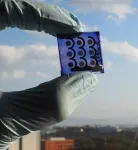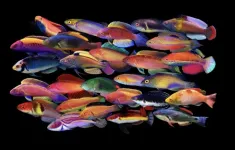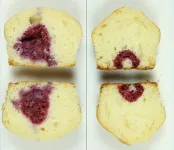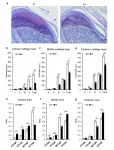Staying in the shade: how cells use molecular motors to avoid bright light
Research team led by the University of Tsukuba discover new component of molecular motors that drive cellular movement in response to light
2021-03-01
(Press-News.org) Tsukuba, Japan - Single-celled algae and animal sperm cells are widely separated in evolution but both swim in the same way, by waving their protruding hairs, called cilia or flagella. Motion is driven by molecular motors, complex assemblies of proteins that exert a force when changing shape. The motor proteins are connected to the cell's internal skeleton of microtubules; the moving force from the motor causes microtubules to slide, moving the flagella and propelling the cell.
Now a team led by Professor Kazuo Inaba of the University of Tsukuba in collaboration with scientists from Osaka University, Tokyo Institute of Technology and Paul Scherrer Institute has described a new protein that is closely associated with one class of motors, called dyneins. They recently published their findings in Science Advances.
The team isolated molecular motor complexes from sperm cells of a marine invertebrate, the sea squirt Ciona intestinalis. Among the components, they discovered a novel protein related to a protein with a blue-light sensing function, called BLUF. They named the new protein "DYBLUP" for dynein-associated BLUF protein. Comparing gene sequences, they found DYBLUP has been conserved during evolution across a wide range of organisms, from some fungi and algae to animals (but is not found in arthropods or higher plants).
Working with the single-celled alga Chlamydomonas, the team used powerful electron microscopy techniques to show that DYBLUP is part of the molecular tether linking the motor protein to the microtubules.
They then showed that DYBLUP is also involved in regulating the motor in response to light. Chlamydomonas cells normally swim towards dim blue light but away from bright blue light, which damages the cells. Mutant cells of the algae that lacked DYBLUP behaved like normal cells in dim blue light. Initially they avoided strong blue light, but over time they became accustomed to and were then strongly attracted towards it.
"We have discovered a new feature of molecular motors", says Professor Inaba, corresponding author. "Not only is DYBLUP conserved widely across different species, it's also involved in responses to light. In mutant Chlamydomonas cells without DYBLUP protein, it seems the linkage between the motor and the cell skeleton is partly broken, leading to uncontrolled beating of the flagella and altered cell behavior in blue light."
"Both the function and evolution of DYBLUP are fascinating," Professor Inaba continues. "Greater understanding of this protein might also open the way for new technologies to manipulate molecular motors, perhaps using light as a trigger."
INFORMATION:
The article, "A dynein-associated photoreceptor protein prevents ciliary acclimation to blue light", was recently published in Science Advances at doi.org/10.1126/sciadv.abf3621
[Attachments] See images for this press release:
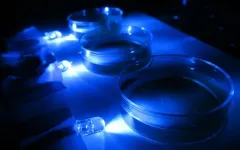
ELSE PRESS RELEASES FROM THIS DATE:
2021-03-01
While many people believe misinformation on Facebook and Twitter from time to time, people with lower education or health literacy levels, a tendency to use alternative medicine or a distrust of the health care system are more likely to believe inaccurate medical postings than others, according to research published by the American Psychological Association.
"Inaccurate information is a barrier to good health care because it can discourage people from taking preventive measures to head off illness and make them hesitant to seek care when they get sick," said lead author Laura D. Scherer, PhD, with the University of Colorado School of Medicine. "Identifying who is most susceptible to misinformation ...
2021-03-01
Electric scooters or "e-scooters" are taking over cities worldwide and have broad appeal with tourists. Although e-scooter use declined during the COVID-19 pandemic, its popularity could rebound rapidly, especially if travelers start to substitute scooters for transit on some shorter trips. Shared e-scooters in particular, are a rapidly emerging mode of transportation, but present a host of regulatory challenges from equitable distribution to parking infrastructure to pedestrian safety, among others.
Understanding travel demand patterns of shared ...
2021-03-01
An associate professor from RUDN University found out the effect of the number and size of pores on the permeability of bone implants by biological fluids. The results of the study could help choose the optimal physical parameters of implants. The results of the study were published in the International Journal of Engineering.
For an implant to survive in the body and to take the place of bone tissue, it should be made of a non-toxic, biologically inert, and wearproof material. However, at the same time, it should be light, porous, and permeable by biological liquids. If an implant does not interfere with the transfer of oxygen, minerals, and nutrients, new bone tissue and blood vessels start to grow around it, and a patient's ...
2021-03-01
Osaka, Japan - Osaka University researchers employed machine learning to design new polymers for use in photovoltaic devices. After virtually screening over 200,000 candidate materials, they synthesized one of the most promising and found its properties were consistent with their predictions. This work may lead to a revolution in the way functional materials are discovered.
Machine learning is a powerful tool that allows computers to make predictions about even complex situations, as long as the algorithms are supplied with sufficient example data. This is especially useful for complicated ...
2021-03-01
With their exuberant colours, fiery personalities and captivating courtship displays, the fairy wrasses are one of the most beloved coral reef fish. Despite this, the evolutionary history of its genus was not well understood - until now.
Fairy wrasses diverged in form and colour after repeated sea level rises and falls during the last ice age, finds a new study. Published in top journal Systematic Biology, it employed a novel genome-wide dataset to make this discovery.
Lead author, ichthyologist and PhD candidate at the University of Sydney, Mr Yi-Kai (Kai) Tea, says ...
2021-03-01
Osaka, Japan - Nature is full of diversity, but underneath the differences are often shared features. Researchers from Japan investigating diversity in plant features have discovered that plant root tips commonly converged to a particular shape because of physical restrictions on their growth.
In a study published in February in Development, researchers from Osaka University, Nara Institute of Science and Technology, and Kobe University have revealed that plant root tips are constrained to a dome-shaped outline because of restrictions on their tissue growth. This study is one of the papers selected as a Research Highlight published in this issue of Development ...
2021-03-01
Raspberry muffins are in our future.
Washington State University scientists have figured out a way to treat raspberries before they're frozen so that they maintain their structure when thawed.
The tart little berries are very delicate and freezing damages their cells. They turn to mush when baked and leak juice into the surrounding baked product, making them unattractive and diluted in flavor. As a result, frozen raspberries are rarely used in baking, whether at home or in commercial bakeries. But that's about to change.
In a recent article published in Food and Bioprocess ...
2021-03-01
Making cheese leaves a lot to chance as a batch could be ripened for months or even years before a problem is discovered, which could send a prized batch of cheddar to be sold off cheap as an ingredient for processed cheese.
It's part of why cheese is so complex and expensive to make - a factory could invest lots of time and money into what they think will be a top-graded batch, only to discover it's a flop when it's too late to fix.
But new research from RMIT University in Melbourne, Australia allows quality to be checked much earlier and more precisely in the process, giving manufacturers a better chance to react to issues with the ripening process.
Dr ...
2021-03-01
Researchers from Tokyo Medical and Dental University (TMDU) observe underdeveloped jaw cartilage in newborn rats exposed to periods of low oxygen
Tokyo, Japan - Breathing in adequate amounts of oxygen is critical for human life. However, certain disorders can cause individuals to go through periods where they are exposed to periodical low levels of oxygen, called intermittent hypoxia (IH). This is common in people who suffer from some sleep disorders like obstructive sleep apnea. Although we know IH can cause neurological development issues, it is not clear how it affects cartilage. Now, researchers at Tokyo Medical and Dental University (TMDU) have shown that IH can result in underdeveloped jaw cartilage in rats.
In an article published in Scientific Reports, researchers ...
2021-03-01
HIV infections are treated with antiviral drugs which effectively prevent the disease from developing. While pharmacological HIV therapy has advanced considerably, the virus cannot be entirely eliminated from the body with currently available drugs.
However, in roughly one-fifth of HIV patients the immune system does not recover as expected: the quantity of CD4 T cells, reflecting the status of the immune system, remains low even when the quantity of HI viruses in blood is suppressed to very low levels or below the measurement threshold. In such patients, indications of chronic immune activation, which erodes the immune system, can be detected.
In cooperation with the University of Erlangen-Nuremberg in Germany, researchers at the University of Helsinki have ...
LAST 30 PRESS RELEASES:
[Press-News.org] Staying in the shade: how cells use molecular motors to avoid bright light
Research team led by the University of Tsukuba discover new component of molecular motors that drive cellular movement in response to light



